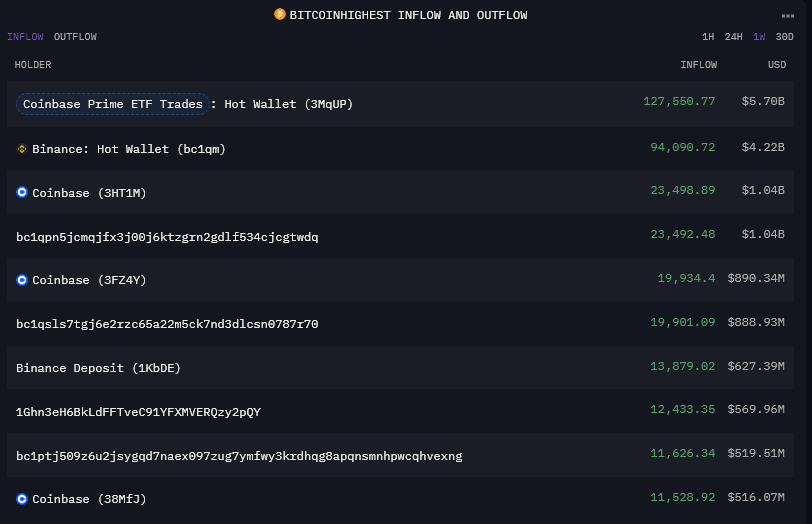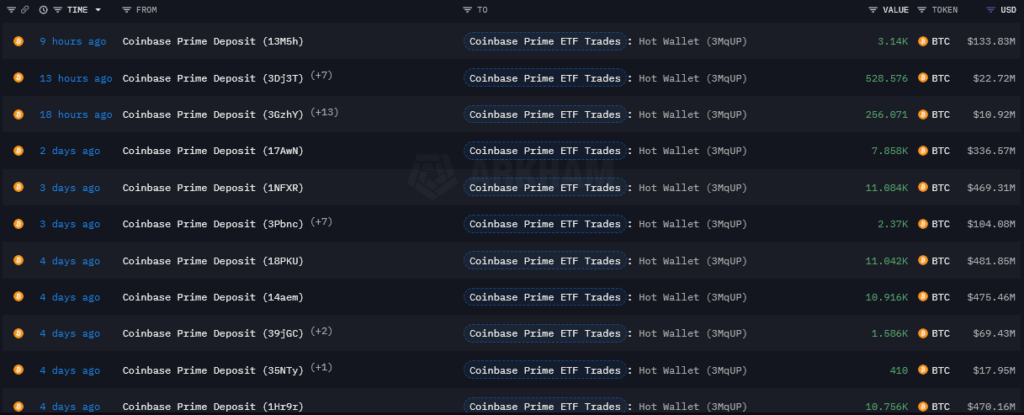Coinbase Prime, the crypto platform explicitly designed for institutional investors, trusts and high-net-worth individuals, has seen a dramatic increase in trading activity following the launch of the US spot Bitcoin ETFs.
CryptoSlate Analysis identified a hot wallet at Coinbase Prime that has risen to the top of the Bitcoin inflow chart over the past week. This wallet, which is used for trading activities within the platform, saw modest inflows and outflows of hundreds of millions over the course of a month in 2023. However, last week saw an inflow of $5.7 billion and an equivalent amount of outflow. . Historically, Binance’s hot wallet has dominated the power rankings, and from the data analyzed, this appears to be the first time Coinbase Prime has surpassed Binance in seven days.

Over the past 30 days, Binance continues to lead the way with inflows and outflows of about $14 billion, while Coinbase Prime lags slightly behind at about $12 billion. It is worth noting that other trading wallets have been tagged as belonging to Coinbase Prime on Arkham Intelligence. However, this wallet seems to be able to handle large transactions.
The increase in activity can be seen in the table below, which only shows transactions larger than $10 million. In the last four days alone, several deposits of more than $400 million have been made in one transaction.

The visualization below shows the flow of transactions over $50 million for the Coinbase Prime hot wallet. The left cluster is tagged as Coinbase Prime deposit addresses, all of which end up in the hot wallet. The cluster on the right contains wallets also tagged as Coinbase Prime deposit addresses, but shows inflows and outflows. The wallets in the bottom cluster are not tagged and only show outflows from the hot wallet. The biggest outlier is the Coinbase exchange, which shows a single outflow of $78 million.

Speculatively, the left cluster could show deposit addresses for institutions, the right wallets could be the trading wallets, and the bottom wallets could be cold storage. None of this is verifiable at this time, but it could potentially line up with data in the ETF prospectuses about how Bitcoin trading works for the funds. Please note that the above only shows transactions over $50 million, or approximately 1,100 BTC.
The chart below contains transactions starting at $1,000, with all of the above wallets locked in place. Strikingly, the bottom cluster still shows no inflow, while dozens of new wallets with these lower values have entered the arena.

Efforts to identify and analyze portfolios associated with ETF activity could provide important insights into the Bitcoin market if trading volumes continue to track launch data. With CoinShares reporting approximately $17.5 billion in trading volume among crypto-financial products last week, this activity will impact Bitcoin’s spot price in a different way.
The price at which the ETFs value Bitcoin on a daily basis is calculated via the CF Benchmarks Index, BRR, which stands for the Bitcoin Reference Rate. This rate is calculated daily between 3:00 PM and 4:00 PM GMT by analyzing a series of transactions on different exchanges. The BRR is then used to calculate the net asset value of the funds, and therefore the value of the Bitcoin they hold. This pace and the fact that share creation and redemptions occur outside of standard trading hours adds a new dynamic to Bitcoin trading that has not been a factor until now.

